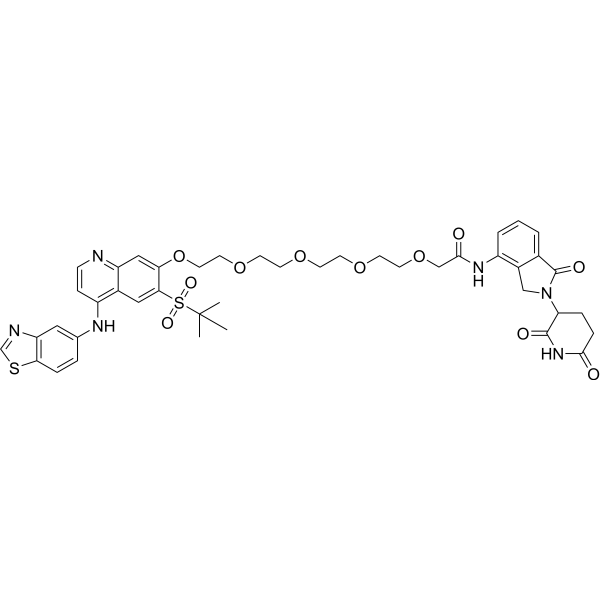Physicochemical Properties
| Molecular Formula | C43H48N6O11S2 |
| Molecular Weight | 889.0048 |
| Exact Mass | 888.282 |
| CAS # | 2089205-64-9 |
| PubChem CID | 126696039 |
| Appearance | Light yellow to yellow solid powder |
| LogP | 3 |
| Hydrogen Bond Donor Count | 3 |
| Hydrogen Bond Acceptor Count | 15 |
| Rotatable Bond Count | 21 |
| Heavy Atom Count | 62 |
| Complexity | 1650 |
| Defined Atom Stereocenter Count | 0 |
| SMILES | S(C1=C([H])C2=C(C([H])=C([H])N=C2C([H])=C1OC([H])([H])C([H])([H])OC([H])([H])C([H])([H])OC([H])([H])C([H])([H])OC([H])([H])C([H])([H])OC([H])([H])C(N([H])C1=C([H])C([H])=C([H])C2C(N(C([H])([H])C=21)C1([H])C(N([H])C(C([H])([H])C1([H])[H])=O)=O)=O)=O)N([H])C1C([H])=C([H])C2=C(C=1[H])N=C([H])S2)(C(C([H])([H])[H])(C([H])([H])[H])C([H])([H])[H])(=O)=O |
| InChi Key | BRZGXSNAXRPPFI-UHFFFAOYSA-N |
| InChi Code | InChI=1S/C43H48N6O11S2/c1-43(2,3)62(54,55)38-22-29-32(46-27-7-9-37-34(21-27)45-26-61-37)11-12-44-33(29)23-36(38)60-20-19-58-16-15-56-13-14-57-17-18-59-25-40(51)47-31-6-4-5-28-30(31)24-49(42(28)53)35-8-10-39(50)48-41(35)52/h4-7,9,11-12,21-23,26,35H,8,10,13-20,24-25H2,1-3H3,(H,44,46)(H,47,51)(H,48,50,52) |
| Chemical Name | 2-[2-[2-[2-[2-[4-(1,3-benzothiazol-5-ylamino)-6-tert-butylsulfonylquinolin-7-yl]oxyethoxy]ethoxy]ethoxy]ethoxy]-N-[2-(2,6-dioxopiperidin-3-yl)-1-oxo-3H-isoindol-4-yl]acetamide |
| HS Tariff Code | 2934.99.9001 |
| Storage |
Powder-20°C 3 years 4°C 2 years In solvent -80°C 6 months -20°C 1 month |
| Shipping Condition | Room temperature (This product is stable at ambient temperature for a few days during ordinary shipping and time spent in Customs) |
Biological Activity
| Targets | Cereblon |
| ln Vitro | Proteins and other peptides that bind to the brain on the one end and the target protein (RIP2 kinase) on the other can be targeted and degraded using PROTACs. These substances form a ternary complex with E3 ligases that proximately binds the target protein, causing polyubiquitination and subsequent degradation [1]. |
| References |
[1]. Compounds for the modulation of rip2 kinase activity. WO2017046036A1. |
Solubility Data
| Solubility (In Vitro) | DMSO : 100 mg/mL (112.49 mM) |
| Solubility (In Vivo) |
Solubility in Formulation 1: ≥ 7.5 mg/mL (8.44 mM) (saturation unknown) in 10% DMSO + 40% PEG300 + 5% Tween80 + 45% Saline (add these co-solvents sequentially from left to right, and one by one), clear solution. For example, if 1 mL of working solution is to be prepared, you can add 100 μL of 75.0 mg/mL clear DMSO stock solution to 400 μL PEG300 and mix evenly; then add 50 μL Tween-80 to the above solution and mix evenly; then add 450 μL normal saline to adjust the volume to 1 mL. Preparation of saline: Dissolve 0.9 g of sodium chloride in 100 mL ddH₂ O to obtain a clear solution. Solubility in Formulation 2: ≥ 7.5 mg/mL (8.44 mM) (saturation unknown) in 10% DMSO + 90% (20% SBE-β-CD in Saline) (add these co-solvents sequentially from left to right, and one by one), clear solution. For example, if 1 mL of working solution is to be prepared, you can add 100 μL of 75.0 mg/mL clear DMSO stock solution to 900 μL of 20% SBE-β-CD physiological saline solution and mix evenly. Preparation of 20% SBE-β-CD in Saline (4°C,1 week): Dissolve 2 g SBE-β-CD in 10 mL saline to obtain a clear solution. (Please use freshly prepared in vivo formulations for optimal results.) |
| Preparing Stock Solutions | 1 mg | 5 mg | 10 mg | |
| 1 mM | 1.1249 mL | 5.6243 mL | 11.2486 mL | |
| 5 mM | 0.2250 mL | 1.1249 mL | 2.2497 mL | |
| 10 mM | 0.1125 mL | 0.5624 mL | 1.1249 mL |
